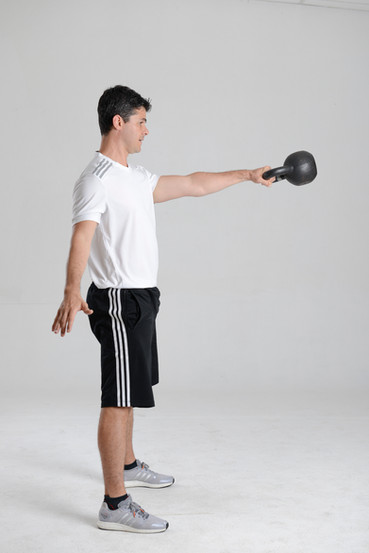Africa Madueño Alarcón Reviews Elbow Injuries and How to Avoid Them
Anyone who plays golf for a long enough period of time, will know someone who has or is struggling with a golf related injury. Research indicates that 50% -- half of all golfers suffer from pain and recurring injuries.

But why is that number so high and how can we avoid this?
The number one predictor of an injury is previous injury. Pain and fear can provoke or trigger changes in our movement pattern, generating stress in other areas of the body. These changes may not even be intentional but are often unintentional or occurs on a subconscious level.
Golf is a sport that depends on high repetition of certain movement patterns. The swing itself is a unilateral movement that can cause muscle imbalances and asymmetries when performed obsessively and without proper physical readiness.
That is why it’s so important to be physically evaluated by a professional, your professional trainer or coach can assess your risk and tendencies, helping you to learn how to avoid overload.
The main causes for an injury to happen are:

Poor swing mechanics
Muscle imbalances and Asymmetry
Excessive practice
No regular/customized exercise program
Improper club fitting
Do golfers incur some types of injuries over others? Of course, for example, elbow injuries are one of the injuries most frequently experienced by golfers – it is one of the top 10 injuries that a golfer may experience. But not all elbow injuries are equal.
The differences between a professional player and a recreational player is that the “injury mechanics” differ significantly. I will look briefly at what these differences are and then share with you some exercises that I usually have my players perform when they need to address or avoid these types of injuries.

There is a myth that many golfers have regarding elbow injuries – namely that golfers tend to have injuries on the medial part (internal portion) of the elbow.
A term for this injury was even created called “golfers elbow” (or medial epicondylitis). In reality, research shows that golfers tend to have more injuries on the lateral part of the elbow (external) and this injury goes by its own common name of “tennis elbow” (lateral epicondylitis).

So how does one develop “golfers elbow”? And, how does one develop a “tennis elbow”?
A “golfers elbow” occurs when one puts too much stress on their wrist flexors muscles.
And “tennis elbow” develops when one puts too much stress on their wrist extensors muscles.
Usually elbow injuries are related to impact and this opens a big spectrum of movement patterns, so we need to observe the hands position of an amateur x professional golfer during impact.

"Exercises such as "pull downs" with an elasticized resistance strap can help strengthen the forearm"
Professionals usually impact the ball with a little bit of bowing on their lead wrist and extension on the trail wrist.
Recreational players on the other hand (especially high handicap players) impact the ball with weird wrist movements like cupping and scooping in an attempt to raise the ball and compensate for poor sequencing and rotational movements. Usually they have the lead wrist in an extended position and the trail wrist on flexion.
Therefore, professionals will tend to damage the ligaments and muscles on their trail arm whereas amateurs tend to injure their lead arm but, for different reasons.
So what can we do to avoid elbow injuries?

Forearm strength training;
Soft tissue release on the forearm region after a long day of playing and practice (using a massage ball or roller);
Correct improper mechanics technique by improving low body action;
Improve golf swing sequence to avoid excessive use of the upper body during the swing;
Avoid hard surfaces when hitting balls ( so take your free drop from the cart path instead trying the “hero shot”);
Avoid over-training.

Kettlebell exercises are another good exercise option for golfers as the gripping of the kettlebell itself promotes forearm strength. In the example to the left, they are using the kettlebell as part of the "Russian Twist" drill, whereby they lift the kettlebell from one side to the other, promoting grip strength and also good core stability and movement. Further, this exercise is great for everyone regardless of gender.
An important note for readers is that these drills or exercises shown here are some of the drills that I use with my players. You should discuss your individual needs with a certified fitness professional before embarking on your own program.
Remember, if you sustain an injury, get it looked at by your medical practitioner so that you can diagnose the injury properly. Once you do that, then you will be able to see your fitness or training specialists to work on rehabilitating the area.
Below is a slideshow with different types of exercises that generally focus on forearm strength.
Africa Madueño Alarcón attended the University of Sao Paulo (Brazil), graduating with a degree in physical education. She has been a pioneer in the physical fitness and training field, particularly with professional and amateur golfers since 2005. Prior to becoming a regular contributor for World of Golf, Africa was the physical trainer for the Brazilian Golf Federation. She is a TPI (Titleist Performance Institute) certified Level 3 – Fitness trainer and has completed her TPI level 2 Medical Certification.
About Africa
to contact Africa about an appointment or
consultation contact her at
email africa@golfefit.com
IG golfefit
.png)




















Comentários